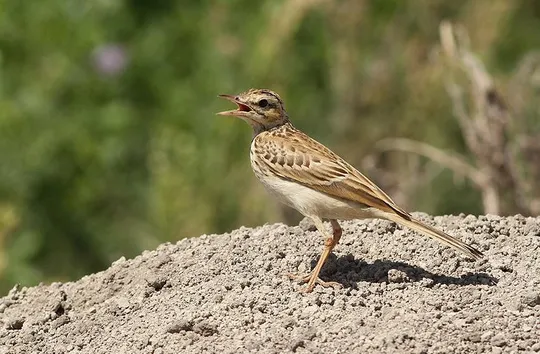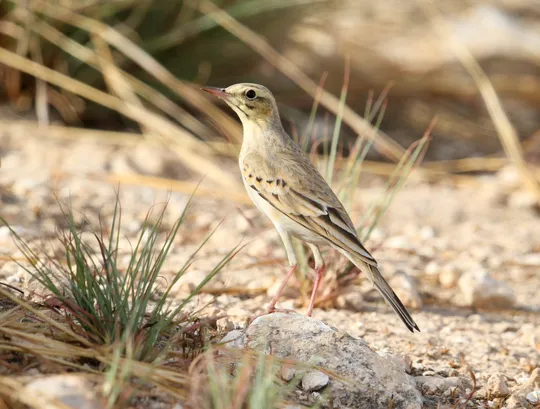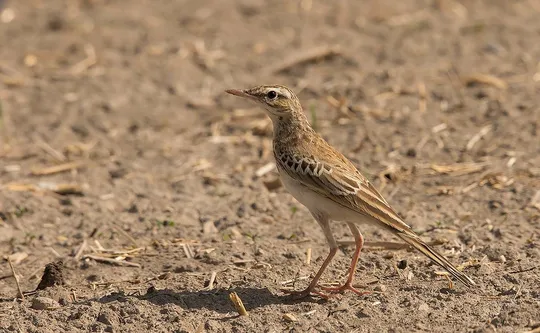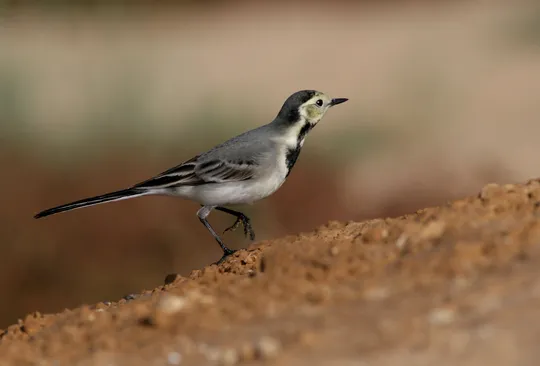Anthus campestris
 Critically Endangered
Critically Endangered




| Habitats | Alpine Scrubland, Mountainous Terrain |
|---|---|
| Presence In Israel | Migrant, Summer |
| Breeding In Israel | Breeder |
| Migration Types | Long Range |
| Zoographical Zones | Alpine, Mediterranean |
| Landscape Types | Mountainous |
| Vegetation Types | Steppe, Herbaceous |
| Vegetation Densities | Low |
| Nest Locations | Ground |
| Diet Types | Invertebrate |
| Foraging Grounds | Ground |
| Body Sizes | Small (up to 500g) |
| Threat Factors | Tree planting, Habitat loss and fragmentation |
The Tawny Pipit is relatively large and pale with slender elongated body and tail that are reminiscent of a wagtail. Its general color is sandy brown, with long legs and a prominent light eyebrow above a dark moustache. Flight call is short, harsh, and reminiscent of the House Sparrow. Song is disyllabic and metallic, usually sounded in flight.
The Tawny Pipit is an extremely rare summer breeder in Israel, restricted almost exclusively to Mt. Hermon, and a common passage migrant. About 10 pairs nest on the Hermon slopes (Israeli & Perlman 2013). In the past, the Tawny Pipit was a relatively common breeder in northern and central Israel (Meinertzhagen 1920). Until the 1980s, it nested in small numbers along the mountains of Judea, Samaria and the Galilee, such as Mt. Ba’al Hatsor, the Jerusalem Hills, the Etzion Block, the Hebron Mountains and Mt. Kna’an (Paz 1986, Shirihai 1996). It has disappeared from most of these areas as a breeder because of habitat destruction related to expansion of settlements, agriculture, afforestation and decreased grazing in the Galilee (leading to thickening of the vegetation). During the last two decades, only a few observations outside upper Mt. Hermon were recorded, indicating sporadic nesting on the southern slopes of the Judean Mountains. On Mt. Hermon its range has become reduced, and while in the 1980s it was recorded breeding at altitudes of 1,300 meters and higher, in recent years only few individuals have been observed and at higher altitudes, above 1,900 meters (Israeli & Perlman 2013).
The Tawny Pipit nests in open rocky mountain peaks in the Steppe and Mediterranean regions at altitudes of 600 m and more.
The Tawny Pipit is affected mainly by habitat destruction and modification due to settlement, roadbuilding, afforestation and decreased grazing in Judea and Samaria, as well as by infrastructure development on the Mt. Hermon heights.
No specific conservation measures have been taken for this species to date.
The most significant Tawny Pipit population breeds on the Mt. Hermon summit. Any habitat development or modification in its breeding areas should be avoided. In addition, a survey of historical breeding sites on the Judean and Samarian mountains should be conducted to assess whether there are any relictual populations in these areas and if so, how they can be protected.
- ישראלי, נ. ופרלמן, י. 2013. סיכום סקר עופות מקננים בחרמון. דו"ח מרכז הצפרות של החברה להגנת הטבע.
- פז, ע. 1986. עופות. מתוך אלון, ע. (עורך), החי והצומח של ארץ ישראל. כרך 6. הוצאת משרד הביטחון, ישראל.
- Shirihai, H., 1996. The Birds of Israel. Academic Press, London.
- Symes, A. 2013. Species generation lengths. Unpublished, BirdLife International.
- Species page at Birdlife International
Current Occupancy Map
| Data Missing | Sporadic | Limited Sites | Low Density | High Density |
|---|---|---|---|---|
| 0 | 0 | 0 | 0 | 0 |
Distribution maps
The maps presented here provide visual information on the distribution of species in Israel from the past and present, and the changes in occupancy and breeding density during the comparison period. For further reading
Relative Abundance 2010-2020
Breeding density values in the current decade as determined from experts' opinion and observations from databases.
| Data Missing | Sporadic | Limited Sites | Low Density | High Density |
|---|---|---|---|---|
| 8 | 12 | 12 | 21 | 19 |
Relative Abundance 1980-1990
Density values based primarily on the book The Birds of Israel (Shirihai 1996).
| Data Missing | Sporadic | Limited Sites | Low Density | High Density |
|---|---|---|---|---|
| 5 | 14 | 14 | 17 | 22 |
Occupancy 1990-2020
The map shows differences in the species breeding distribution between the 1980's breeding map and the current weighted breeding evaluation. Negative value - species previously bred in the grid and is not presently breeding; positive value - species has not previously bred in the grid and is currently breeding.
| Data Missing | No Change | Occupancy Increase | Occupancy Decrease |
|---|---|---|---|
| 6 | 35 | 1 | 9 |
Change in Relative Abundance 1990-2020
The map shows the changes in the relative abundance of a species in each of the distribution grids between the breeding map of the 1980s and the weighted current breeding evaluation. Negative values - decline in abundance; positive values - increase in abundance; zero - no change in abundance.
| 80 to 100 | 50 | 20 to 30 | No Change | 30- to 20- | 50- | 100- to 80- | Data Missing |
|---|---|---|---|---|---|---|---|
| 0 | 4 | 2 | 22 | 12 | 14 | 11 | 16 |
| Rarity | |
|---|---|
| Vulnerability | |
| Attractiveness | |
| Endemism | |
| Red number | |
| Peripherality | |
| IUCN category | |
| Threat Definition according to the red book |
 Contributed:
Contributed: 





